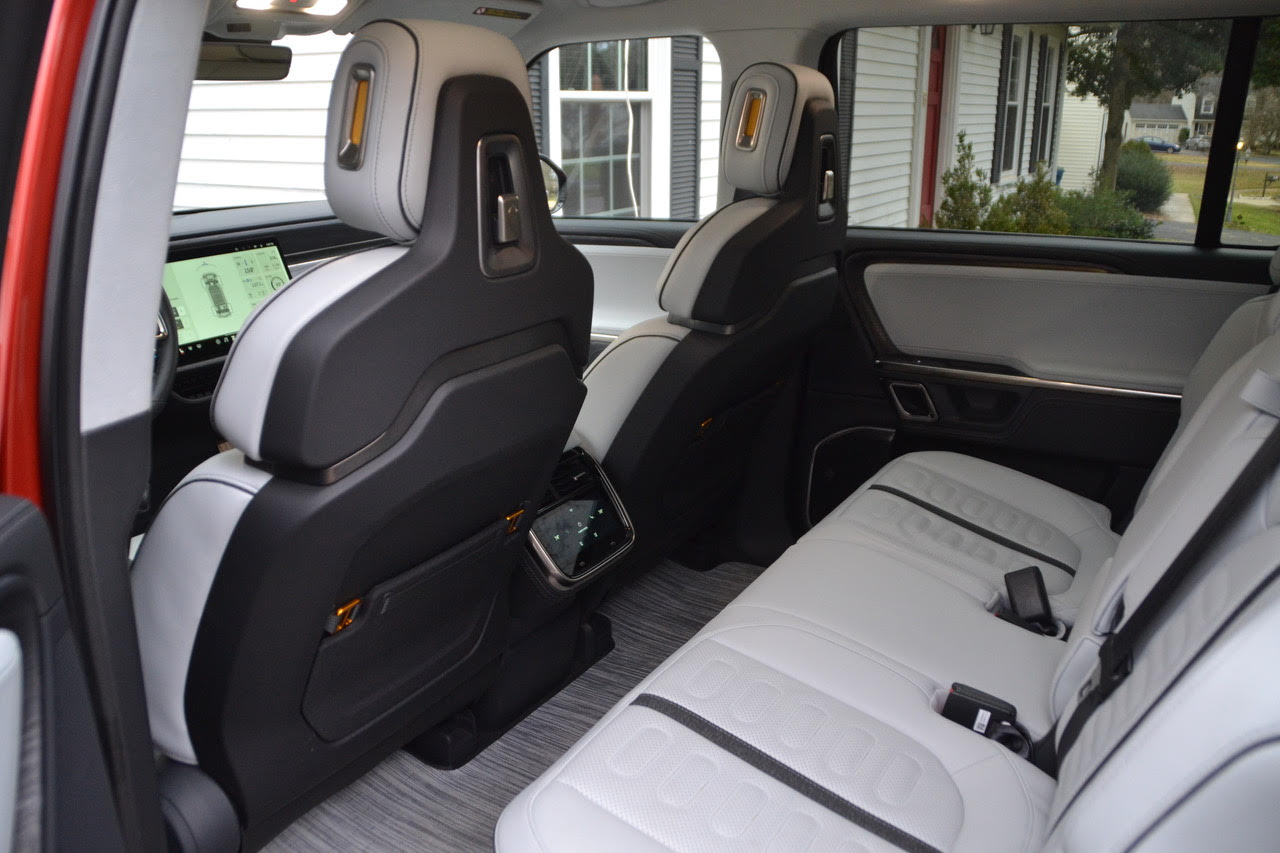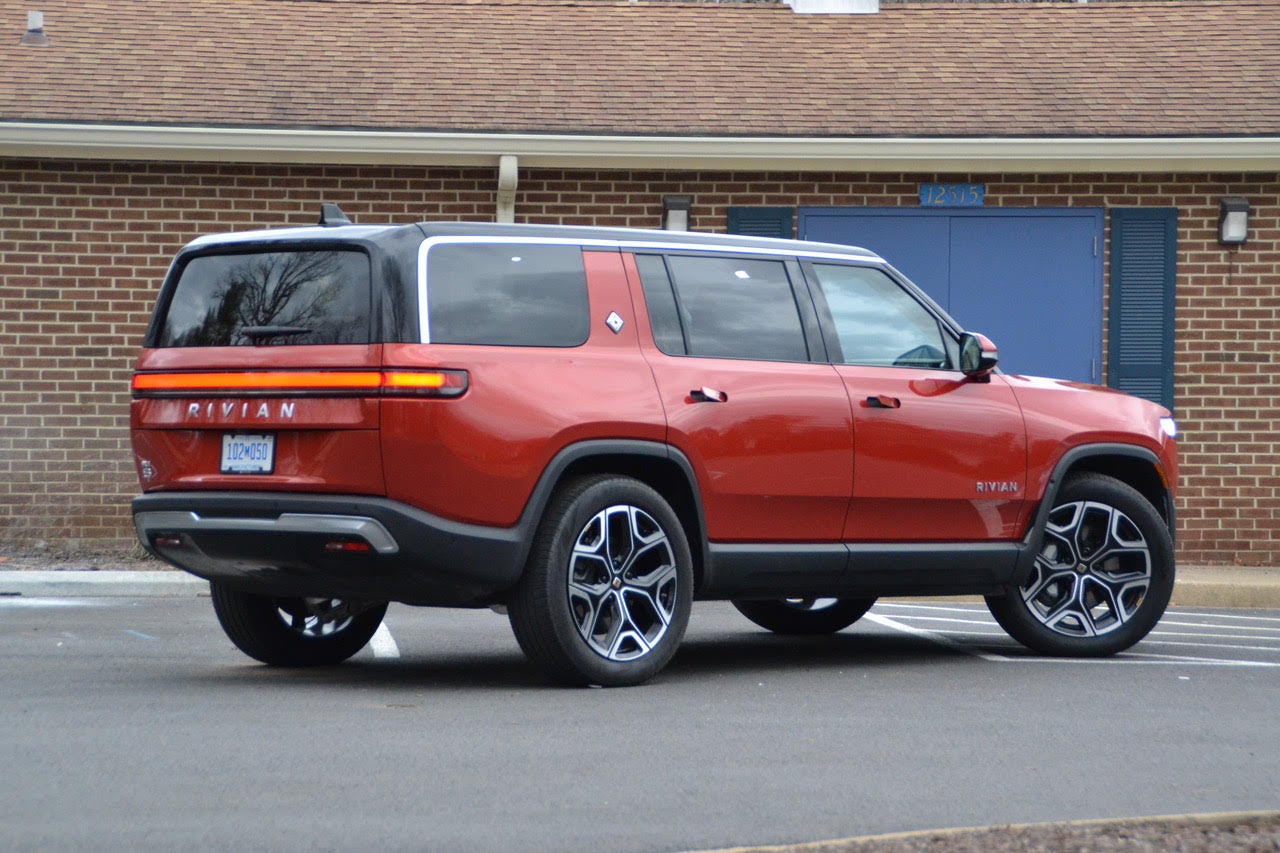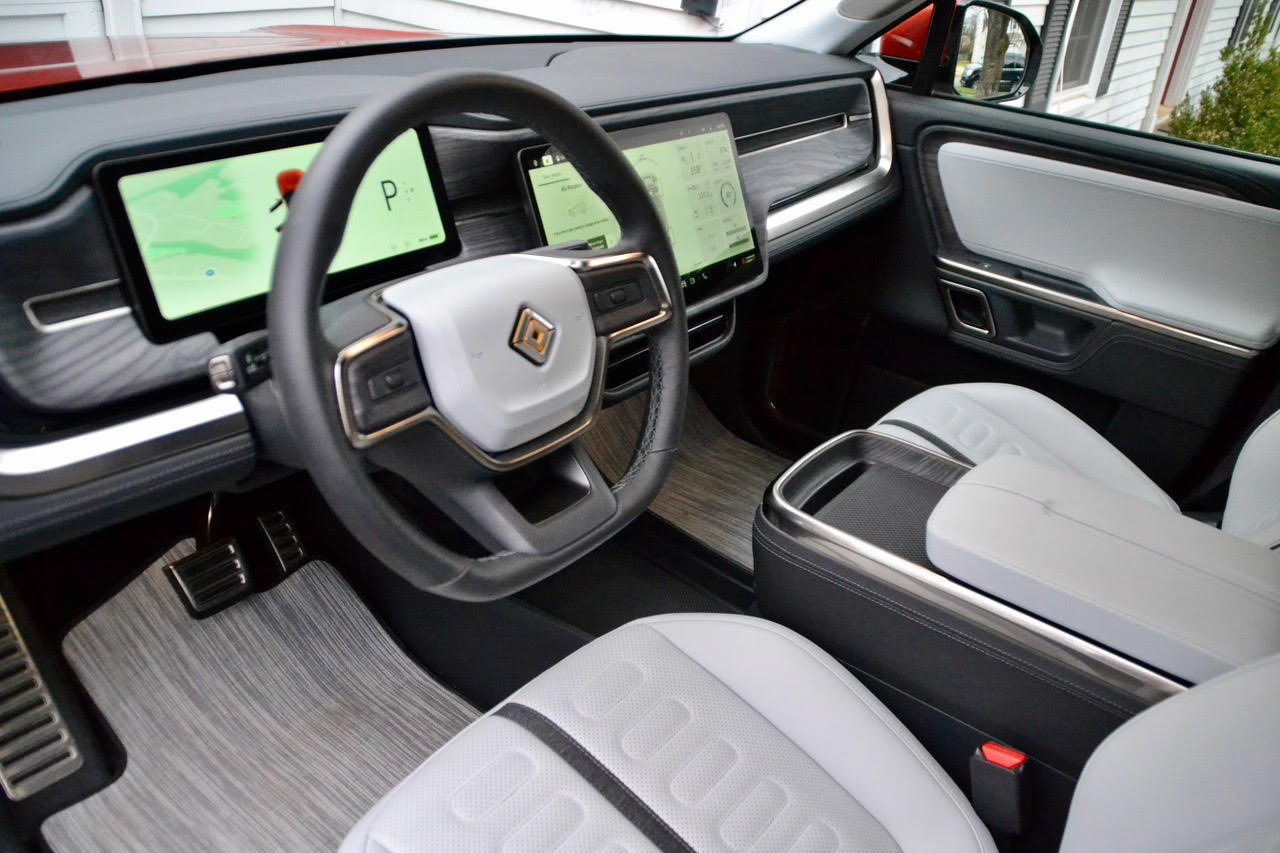That buzzy new restaurant that opened to rave reviews that you loved last year? What if you went back this year for a different dish, only to find that they’d raised their already-premium prices into the four-dollar-sign range? Worse, this time the food left you disappointed and thinking of another hot venue where the prices are lower. That’s where we are with the Rivian R1S battery-electric SUV.
After driving the company’s debut model, the R1T pickup truck in 2021, and getting a preview drive last year of the latest example of the R1S SUV, PopSci got a chance to spend some real time with the that SUV, and unexpectedly, it left me hoping that Rivian’s chefs are open to some suggested improvements.
Rivian launched its business with the R1T pickup, guided by the observation that Americans buy more trucks than any other vehicle type. The R1S is the three-row family-hauling SUV follow-up that sensibly goes after another high-volume, high-margin market segment.
Rivian R1S design
The R1S’s panoramic skylight and third-row sunroof keep the large cabin awash in ambient light, preventing the cave-like effect that long, cavernous vehicles can suffer. The second-row seats are comfortable and their occupants will enjoy the climate control features like seat heaters that keep them happy.

Things in the far-flung third row aren’t as good. Access is challenging, as it takes effort to scramble behind the second-row seats when they are flipped forward into the access position. The journey into the back row isn’t rewarded, as the seat bottoms are practically on the floor and there’s virtually no legroom. These seats are really only suitable only for children, but ones old enough to latch themselves into their booster seats so adults don’t have to clamber back there to do the job.
Rivian R1S motors and range
Apologies for getting down into the weeds now, but we need to establish some technical background for the R1S and R1T’s shared underpinnings. The original versions of the Rivian R1S SUV and the R1T pickup truck that we tested in 2021 are propelled by a quartet of costly electric motors sourced from Bosch. These motors each drive one wheel, providing exquisite computer-metered control of acceleration and regenerative deceleration.
They deliver a combined 835 horsepower and 908 lb.-ft. of torque, which boosts the Rivian to 60 mph in just 3.0 seconds. The 135-kilowatt-hour long-range battery pack is good for 321 miles of driving range.
Alas, the starting price for that version of Rivian’s EVs has risen from $67,500 at launch to $92,000 today for base models with the smallest-available battery pack. Rivian has developed its own in-house electric motors, dubbed “Enduro”, which cost less and make more power than the Bosch motors.
The company installs just two of these stronger motors in place of the four Bosch motors in its new Enduro R1S with a starting base price of $78,000 for the vehicle with the regular 260-mile battery pack and the normal-output dual Enduro motors. In this base configuration, the Enduro motors produce 533 hp and 610 lb.-ft. to push the R1S to 60 mph in 4.5 seconds.
The Dual-Motor Enduro powertrain drives the R1S’s four wheels using one motor in the front and one in the rear, each motor sending power to the right and left sides through a differential just like a combustion-powered vehicle would be. Like many gas-powered 4x4s, the Dual-Motor Rivians control wheelspin using a brake-based traction control system.
In a preview drive last year at Rivian’s Normal, Illinois factory, I got to try the company’s traction-testing mini-mountain. Just as when I drove it in Colorado in 2021, the Quad-Motor Rivian climbed the hill with supernatural capability. In comparison, the Dual-Motor version put some effort into the job of climbing the hill, with the brake traction control system audibly working to clamp down on wheels when they lose grip. The sensation is much like that of a capable combustion-powered off-roader.
Our Rivian R1S setup
This year’s R1S test unit was outfitted with the $16,000 400-mile Max Pack battery and the Performance version of the Enduro motors. This is only a software change from the base Dual-Motor Enduro R1S, unleashing the real capability of the drivetrain, which is 665 hp and 829 lb.-ft. Rivian charges $5,000 to remove the virtual shackles restricting the base model’s performance to accelerate the R1S to 60 mph in 3.5 seconds.
These add-on charges quickly add up, and in the case of our $78,000 base price test vehicle, the price snowballed to an eye-opening $106,000. For the so-called “lower-cost” version! The striking Canyon Red paint contributed $2,500 to that bottom line and the refined-looking Ocean Coast interior theme chipped in another two grand on the bill.
The optional 22-inch wheels added $2,500. The standard wheels are 21 inches, while the available off-road tire uses 20-inch wheels. This was the configuration of the R1T tested previously, and the difference is important.

A bumpy test ride
That’s because the 22s on this vehicle don’t just boost the price to its astonishing total, but they also destroy the ride comfort of the R1S. This isn’t surprising, because larger wheels leave less tire sidewall rubber to cushion impacts. But it is surprising in the case of Rivian vehicles, because they employ the technologically amazing Tenneco cross-linked hydraulic suspension. It has the ability to precisely control the movement of each corner’s suspension.
McLaren Automotive uses the same system on its high-performance sports car to excellent effect. Those cars provide a comfortable ride despite their low-profile high-performance tires thanks to the hydraulic suspension. It seems like Rivian has not successfully exploited this capability.
This fact eluded me in the original test because that vehicle was fitted with the 20-inch off-road tires. But the problem with the 22-inch tires is best described by Rivian itself. The company issued an over-the-air software update in September that it says aimed to provide “reduced abruptness when driving over sharp road impacts in all drive modes, and reduced harshness when driving over bumps and dips at parking lot speeds.”
Those were admirable goals, but those exact problems remain. The Rivian’s ride is harsh, especially on sharp impacts, even small ones. Weather cracks in my street’s asphalt are overlooked while driving anything else. In the R1S, these nearly invisible cracks produce tooth-rattling jolts to occupants.
Neighborhood speed bumps are both harsh on impact and then poorly damped on rebound, when the compressed rear suspension springs back like a pogo stick after landing on the other side of the bump. A Ford Mustang Mach-E tested at the same time provided a positively cushy ride in comparison, with an as-tested bottom line price $10,000 lower than the Rivian’s elusive base price.
Rebound damping is also poor at highway speeds, as I noticed on the extended off-ramp of a nearby highway that has an unfortunate dip in the pavement that puts the spotlight on test cars’ rear suspension control. It revealed the Rivian to be the most deficient yet over this dip in the road.
Blame it on the computers
The hydraulic suspension is computer controlled, and there is the ability to switch between a stiff setting and a soft setting. In theory, this adjustability should mitigate the problems I encountered. In reality, differences were difficult to discern.
This was a theme noticed in other aspects of the Rivian’s computer controlled systems. Another that comes to mind is the following distance setting for the adaptive cruise control. Long or short, the distance is always too far and the difference between the two settings is slight.
Rivian’s automatic lane keeping system is a hands-on-the-wheel system, so don’t expect Ford F-150 Lightning BlueCruise-style hands-free driving on highways. It is a good example of a hands-on system, delivering the steering that the driver expects, unlike early systems that seemed to wrestle with the driver over the vehicle’s direction.
All such driver assistance systems rely on the vehicles’ perception systems, and the Rivian’s cameras watching the road ahead were confused by the white lines of liquid de-icer that had been applied to the road. Rivian’s instrument display shows what the vehicle thinks it sees, and the multitude of white lines in the lane left the R1S disoriented and yanking on the wheel at times when it thought it was crossing out of the lane.
Rivian R1S infotainment
Like so many EV startups, Rivian’s design aesthetic is minimalist, with few physical buttons or knobs. The R1S’s vertically oriented 16-inch central display provides access to most functions. Disappointingly, the convenient frunk open button we asked for in 2021 remains buried in on-screen menus rather than persistently situated in the tray of quick-access icons across the bottom of the R1S’s center display screen where drivers could instantly locate and use it.

Worse, as an SUV, unlike the R1T pickup we drove then, the R1S has a rear hatch that drivers will also want to be able to open quickly and easily. Again, no luck. The on-screen virtual button for the rear hatch resides alongside the frunk button within an on-screen menu.
Rivian does not support either Apple CarPlay or Android Auto, so phone integration is sub-par. Yes, you can pair your phone, but there’s no ability to operate apps on it while driving. Rivian also has no SiriusXM satellite radio receiver. The company has announced plans for an over-the-air update that will add a SiriusXM app to the infotainment system, at least.
This system will let drivers listen to SiriusXM by streaming it over the R1S’s cellular data connection and control the music on screen. The problem with that is that the music depends on a strong cellular signal. While streaming SiriusXM on my paired phone, I lost the signal while driving on an interstate highway 30 miles outside the nation’s capital.
When the phone recovered the signal, the Rivian infotainment system did not resume playing music, so I was left to switch to an FM station until the next stop when I could restart the stream on the phone’s app.
Rivian’s onboard maps app does provide good turn-by-turn directions to often hard-to-find charging stations, which can seem to hide in a maze of strip mall parking lots and gas stations.
Charging challenges
Rivian anticipates that owners will head to the boondocks periodically, which is why the company is building the Rivian Adventure Network of company-operated EV charging stations on the way to outdoor destinations where DC fast charging options may be sparse.
This is smart, but EV charging stations and cellular networks tend to have substantial geographic overlap. Acknowledging the shortage of EV chargers in outdoor areas is a reminder that drivers can reasonably expect there to be spotty cellular coverage, so a SiriusXM app will not work reliably when heading to the outback, while a satellite radio receiver would continue providing music.
When you need to use a DC fast charging station on a public charging network rather than charging at home, Rivian says the R1S will charge at a speedy 220-kilowatt rate, though the Rivian Adventure Network chargers top out at 200 kW.
I went to an Electrify America 350-kW charger and saw a peak charging rate of 50 kW. The battery’s state of charge was 63 percent and the battery temperature was 64 degrees F. This is relevant because EVs taper charging to slower speeds once the state of charge reaches 80 percent because it gets harder to stuff more electrons into a nearly full battery. That wasn’t the case here, and the slow charging also wasn’t because the battery was cold.
Charging at that rate, it would take hours to recharge an empty battery, which would blow up any thoughts of a tolerably quick road-trip top-off. Further, a visit to a brand-new EVgo charging station was a bust, because I couldn’t get the charger and the Rivian to cooperate. That’s when I diverted to the EA charger. A return visit to the EVgo charger later was successful, but when you need a charge, the fact that it might work next time is no help if it doesn’t work now.
Rivian claims an estimated driving range of 400 miles, and due to the wintry driving conditions, the R1S adjusted that estimate to a still-impressive 380 miles. Driving with 21-inch wheels would buy a few more miles because they are lighter than the tested 22s. The 20-inch wheels are a little worse because they only come with the off-road tires that have more rolling resistance.
My highway driving with the cruise control set on 70 mph produced a maximum range of 320 miles, which is still good, and far better than the Ford F-150 Lightning produced in similar conditions. Cruise control is beneficial during highway drives because it helps ensure smooth application of the accelerator. The R1S has adjustable levels of regeneration when the driver lifts off the throttle, but even the lower-level setting is very sensitive and can make it challenging to maintain a consistently steady speed for hours on end.
The high-regeneration mode can be too aggressive, even for a driver like me who appreciates the ability to slow the vehicle to a complete stop without using the brake pedal. It is helpful in stop-and-go traffic and for one-pedal off-road rock crawling, but the lower regeneration mode is better in everyday driving.
However, while it is easy to acclimate to the generally high level of deceleration when lifting off the accelerator, being used to it makes it more unexpected when that deceleration is absent. That’s what happens when you plug in at home for an overnight charge and the battery is fully charged.
With a full battery, there’s nowhere for the electrons coming from the electric motor/generators to go, so there’s no deceleration. It took an emergency stab at the brake pedal to stop the R1S from rolling past the stop sign at the end of my street the first time this happened.
However, when you’re going to do around-town driving and do not need an absolutely full battery, it is better to set the charging settings so that it stops when the battery is at 80 percent. This prolongs the life of the battery pack and also avoids those no-regen surprises.
Enter the R1S app
The R1S’s state of charge is one of the parameters that drivers can view and control using Rivian’s mobile phone app. The Rivian app is notably more responsive than others, especially Ford’s app, when it comes to simple functions like locking and unlocking doors, pre-heating the cabin, and checking or setting the battery charge level.
The app also lets you use the phone as a key, which proves to be surprisingly convenient. Rivian has a stylish key fob that resembles a climbing-gear carabiner that would be fine to use. Alternatively, the company also has a credit card-like card that provides access to the R1S and lets the driver start it.
The phone app is so responsive that there’s really no downside to using it instead of the key fob for routine things. The only potential problem occurs when the driver drops his phone off for a new battery installation and then realizes that the plan to swing by the recycling dropoff location during the service is not possible because he doesn’t have the key fob and the phone has been disassembled. Oh well.
Who should buy the Rivian R1S?
The bottom line is that the Rivian R1S is an impressive technical tour de force that delivers genuine long-range driving on a single charge and the ability to carry the whole family. But the details of the suspension calibration, the on-screen functions, the absence of CarPlay, Android Auto, and a satellite radio receiver, and the slow battery charging make the purchase decision less obvious.
The current pricing settles the question. The six-figure price tag for a vehicle that needs so many improvements makes an easy “no.” The Kia EV9 has appeared on the scene as an alternative three-row electric family SUV boasting a starting price of $54,900 and a “North American Utility of the Year Award.” That is the new benchmark in this vehicle segment.
Corrections 01/01/24 3:31pm: The navigation system is not Google Maps; it is Rivian’s own system. The starting price for the quad motor R1S is $92,000, not $95,000. This review has been updated to reflect this.





